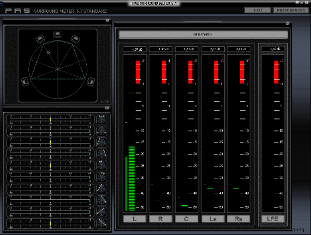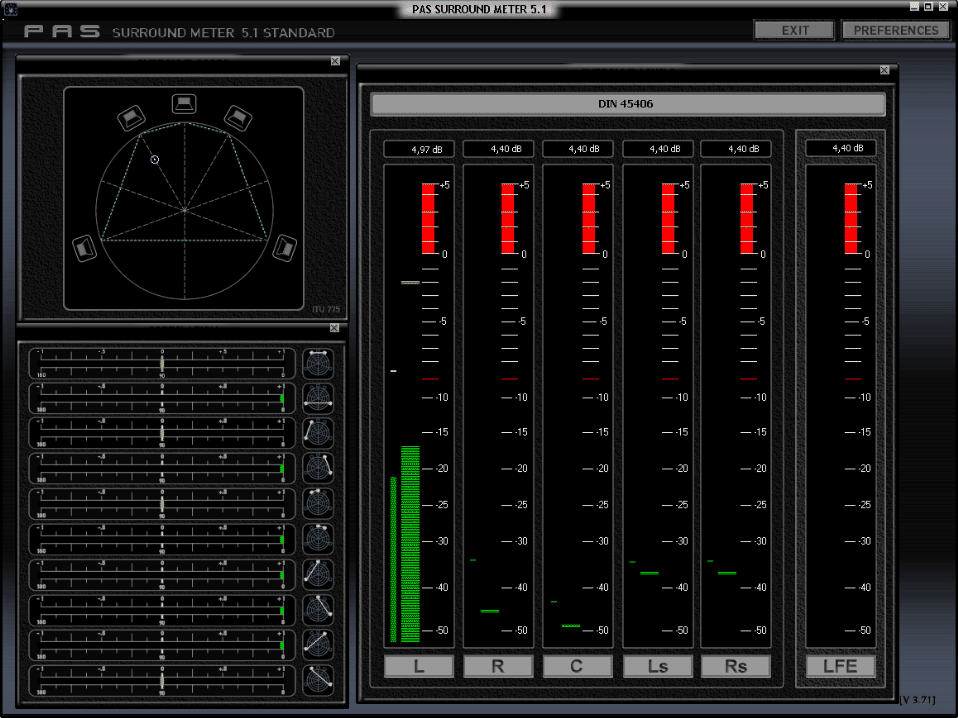
Download some avi-demos, there you can see the movements of the Surround Scope and Levels:
Surround Meter 5.1.wmv (347 kb)
Surround Moves.wmv (2.842 kb) no sound, but you will see...
The application benefit also Live recordings with a automated correction and also it's perfect for Dj's.
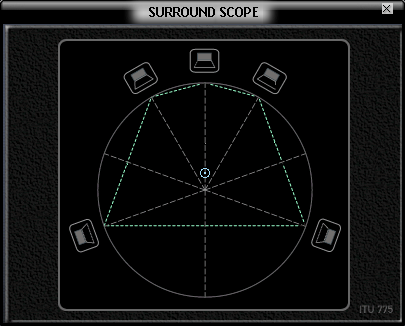
The surround scope
Da
bei einer komplexen Surroundmischung die Aufmerksamkeit und
Konzentrationsfähigkeit des Tonmeisters stark gefordert
ist, soll die begleitende Surroundanzeige auf einen Blick
einen visuellen Status des gesamten Klanggeschehens ermöglichen.
Aus diesem Grunde ist das Design dieser Anzeige bewusst sachlich
und übersichtlich gestaltet.
Links oberhalb des Surround Meters befindet sich eine kreisförmige
Anordnung der 5 Surroundquellen ( Lautsprecher ), die zwar
nicht der Anordnung des bekannten ( und gefürchteten
) ITU-Kreises entsprechen, aber mathematisch exakt durch den
sich im Kreisfeld bewegenden Surroundball das momentane Mischungsverhältnis
aller 5 Quellen zueinander darstellen. Gerade die oft kritische
Balance zwischen den Front und Rearlautsprechern wird hier
sofort deutlich zur Anzeige gebracht. Dies bezieht sich allein
auf die Lautheit aller 5 Kanäle zueinander und nicht
auf deren Phasenbeziehung. Diese wird in der darunter liegenden
Korrelationsanzeige jeweils eines ausgewählten Kanalpaares
zur Anzeige gebracht.
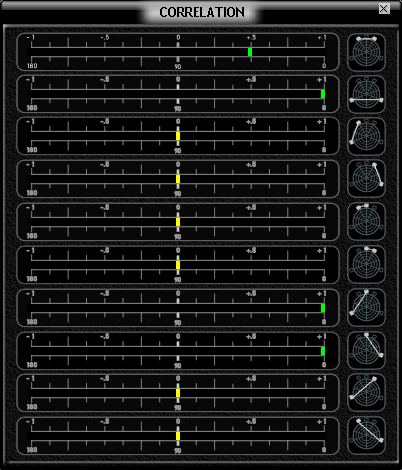
Correlation Meter
Der
Korrelationsgrad ist ein Maß für die Monokompatibilität.
Dieser Wert wird gemessen und auf einer LED-Kette angezeigt.
Sobald diese in den roten Bereich ausschlägt, ist etwas
nicht in Ordnung. Auch auf einem Zweistrahl-Oszilloskop im
XY-Betrieb kann man mit etwas Übung den Korrelationsgrad
ablesen. Ein Monosignal ergibt einen senkrechten Strich, ein
Stereosignal mit korrekter Phase ein kreisförmiges Bild,
und bei zu starker Gegenphase entsteht ein horizontal gerichtetes
Ei.
Da
diese Darstellung recht komfortabel ist, gibt es auch sogenannte
Stereosichtgeräte, die im Gegensatz zum normalen Oszilloskop
speziell für den Anschluß im Studio ausgelegt sind.
Allerdings erfordert das Ablesen etwas Übung, weshalb
das PAS Surround Meter einen anderen Weg geht: Alle zehn möglichen
Kanalpaare sind in einer Anzeige dargestellt, die sich im
Bereich zwischen 0 und +1 bewegen sollte. Schlägt sie
in den Bereich zwischen 0 und -1 aus, ist bei dem betreffenden
Kanalpaar keine Monokompatibilität.
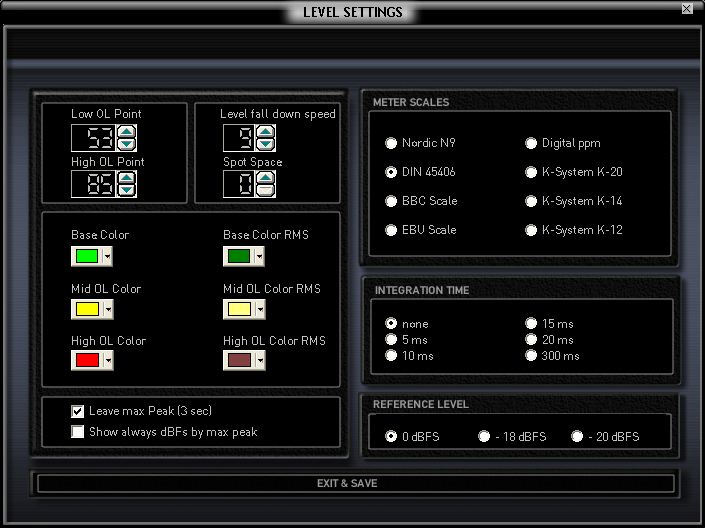
Level Settings
In
diesem Settings-Dialog stehen dem Anwender alle Parameter des
Korrelationsgradmessers zur individuellen Einstellung zur Verfügung
Reverence Level: 0dBFs, -18 dBFs (european broadcast), -20 dBFs (american broadcast)
Mit
dem "High OL Point" und "Low OL Point" stellen
sie zwei Grenzen ein, zwischen denen Sie der Balkenanzeige verschiedene
Farben zuordnen können. Die Farbe "Base Color"
gilt für die Segmente der Balkenanzeige unterhalb des "Low
OL Point", die Farbe "Low OL Color" für
den Bereich zwischen den beiden eingestellten Punkten, und die
Farbe "High OL Color" für den Bereich oberhalb
des "High OL Point". Damit läßt sich das
Aussehen der Anzeige vielfältig verändern und an Ihre
gewohnte Darstellung anpassen.
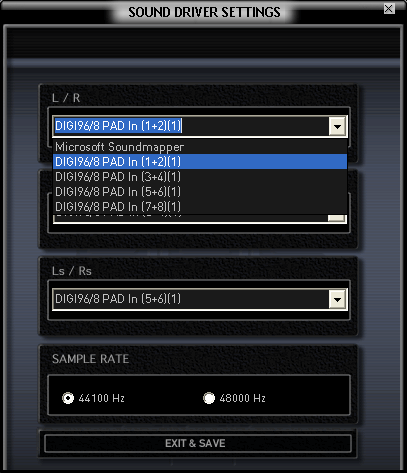
Sound Driver Settings
::
sound Driver Settings
Zum Betrieb des Surround Meter müssen die sechs Summenkanäle
des 5.1-Signals dem Rechner zugeführt werden. Dafür
ist eine mindestens sechskanalige Audiokarte erforderlich, deren
Eingangssignale der Software über die Multimedia-Extension
(MME) von Windows zugeführt werden. Diese Anforderung erfüllt
nahezu jede auf dem Markt erhältliche Mehrkanal-Audiokarte.
In
der Praxis wird in den meisten Fällen eine achtkanalige
Karte zum Einsatz kommen, bei der zwei Kanäle ungenutzt
bleiben. In analoger Studio-Umgebung könnte dies beispielsweise
die in den Screenshots dieser Online-Hilfe zu sehende Arc88
von Marian sein, in digitaler Studio-Umgebung werden dagegen
gern Karten mit ADAT-Schnittstellen eingesetzt, beispielsweise
die Digi-96/8-Serie von RME. Auch bei diesen Karten stehen die
Kanalpaare 1-2, 3-4 sowie 5-6 als separate Stereo-Devices zur
Verfügung.
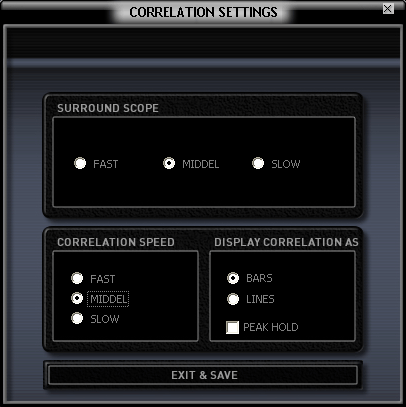
Correlation Settings
In this settings dialogue, the user can carry out his individual adjustment of all parameters of the correlation level indicator. Display correlation as Bars
Here the user can chose between 2 different types of display diagrams. The bar diagram always refers to null. We are aware that the real correlation does not have a relation to null, but this diagram helps to keep a better overview. Of course this is a matter of taste. This is why we also put the lines display as default.

IEC 268-10 Type I - Nordic N9
IEC 268-10 Type IIa - BBC PPM
IEC268-10 Type IIb - EBU PPM
DIN 45406
dB Full Scale
K-System
K-20 K-System
K-14K-System
K-12-System
Credits:
Vielen Dank an Tonmeister Holger SIEDLER THS
Medien und
Dipl.-Ing. Thomas Sandmann Master-Orange
für die nette Unterstützung, fachliche Beratung und diverse
Anregungen.
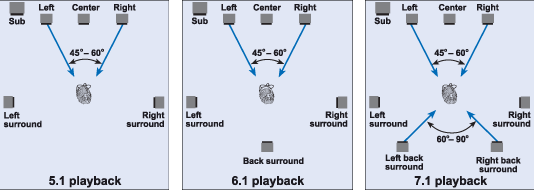
The 5.1-Format offers completely independent channels, with which therefore also the rear loudspeakers can be separately from each other headed for and which entire frequency range to take off. This extended possibilities open clearly with placing the instruments in the area, and klangliche changes by Matrizierung cannot even develop.
Also with the center channel it concerns an individual channel, with whose separate control beyond the possibilities of a LCR Panpots however it should be considered that the phantom center between left and right channel nevertheless further existed and with same signal portions in the center channel can cause extinctions.
On the other hand a situation can be created by skillful placing of some events in the center channel and other one in the phantom center, with which the center signals before a formed texture seem to stand for through left and right channel, which seems to move on change of the hearing position even opposite the center channel.
The name 5,1 states that beside the five Fullrange loudspeakers an additional Subwoofer is used, which is likewise headed for by a discrete channel. This as LFE (Low frequency Effects) did not designate channel serves however for the recording the satellite loudspeakers of completing bass signal. That would be already not meaningful, because with music production does not admit the specific data of the respective hearing plant are. Thus if the frequency response of the five main loudspeakers is not enough far enough down there and if these are to be supported therefore also by the Subwoofer, then this is to be realized rendition-laterally, as it already admits for example from Stereo Subwoofer plants is.
The LFE channel serves excluding the recording of low-frequent effects additionally for the Fullrange range of the main loudspeakers. Here extremely deep basses with high levels and therefore large diaphragm deflections are well waived, which do not load the main loudspeakers any longer.
When mixing in the 5.1-Format clay/tone engineer does not enjoy nevertheless all liberties of the completely discrete channels, because many consumers do not operate their Surround Abspielgeraete at all in the Surround mode. Here an automatic Downmix then often takes place in the playback unit.
This leads on the one hand to the fact that with the Platzieren for example thundering a thunderstorm exclusively in the LFE channel dead silence will prevail completely surely with the users, who did not attach Subwoofer, why one avoids such extreme attitudes with production and always also on the main loudspeakers should put supplementing signal portions.
On the other hand however the rules there always apply for the attention of the phase positions with the pro log IC or Stereo format in the long run also to a 5.1-Mischung, with a later to count automatic Downmix are. But the phase relationships between all pairs of channels must be correct, and appropriate correlation announcements, how them offer the PAS Surround meter, are very helpful.
By the discrete center channel, significant signal portions effects in the LFE channel, important from the rear loudspeakers and, the speech cannot be when exclusive hearing the left and right channel of Stereokompatibilitaet.
Therefore its own mixture is to be made for Stereo listeners, which does not have to be noted however obligatorily on two further channels of the Surround Tontraegers. The format Dolby digital contains meta data so mentioned, in which the controlling of the automatic Downmixes can be given in the playback unit by producing clay/tone engineer. Since this has also effects on the sum levels, the PAS Surround meter refers such measurements into its concept also.
